Organisational Behaviour Analysis: ASDA Case Study Report
VerifiedAdded on 2022/12/14
|18
|6038
|281
Report
AI Summary
This report provides an in-depth analysis of organizational behaviour within ASDA, a major UK supermarket retailer. It examines the influence of organizational culture, power, and politics on individual and team behaviour and performance. The report explores various aspects of organizational culture, including task, power, person, and role cultures, and analyzes different types of power, such as reward, coercive, referent, and legitimate power. Furthermore, it evaluates content and process theories of motivation, including Maslow's hierarchy of needs, and their application within ASDA. The report also discusses the characteristics of effective and ineffective teams, along with group development theories to support dynamic cooperation. Finally, it applies concepts and philosophies of organizational behaviour to a business situation at ASDA, considering both positive and negative influences on behaviour.
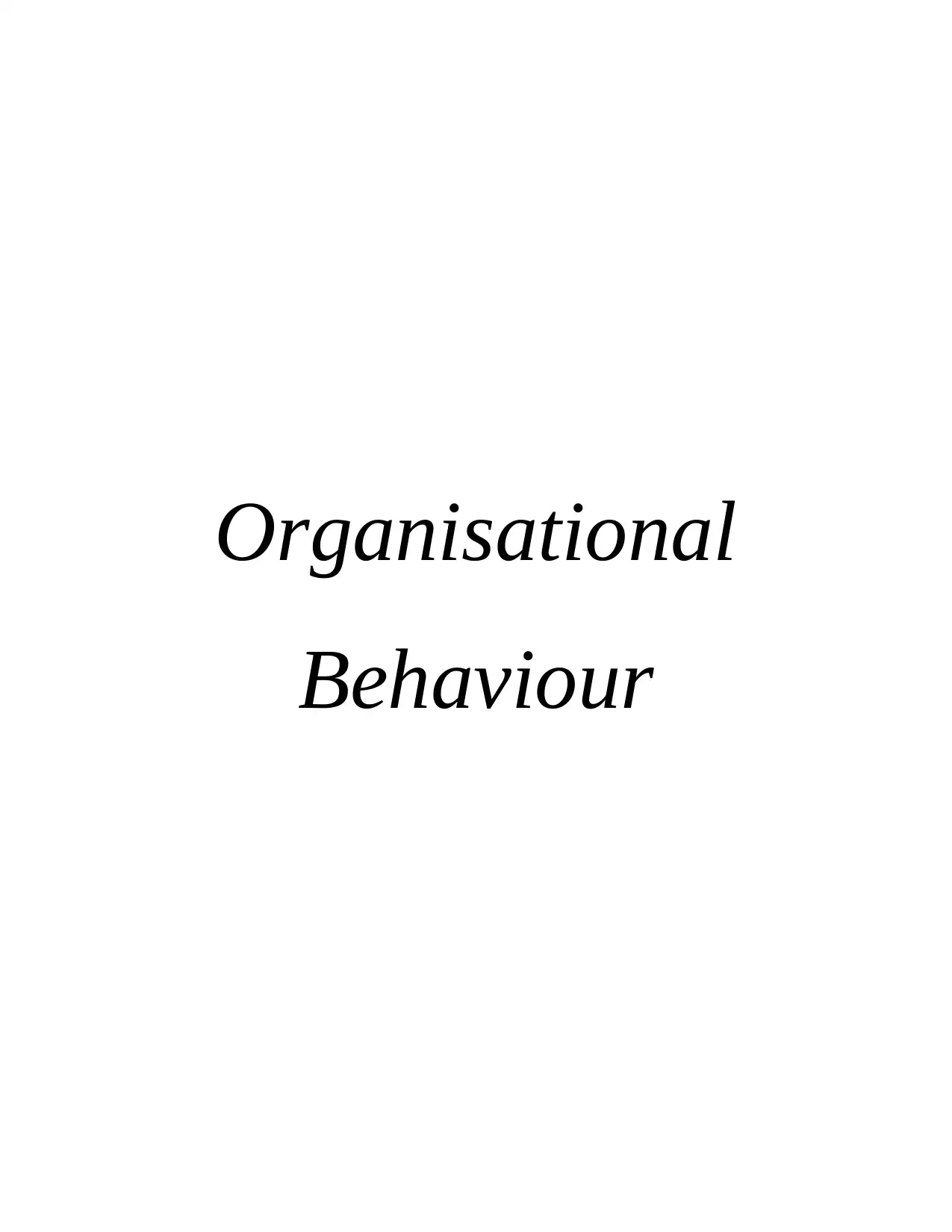
Organisational
Behaviour
Behaviour
Paraphrase This Document
Need a fresh take? Get an instant paraphrase of this document with our AI Paraphraser
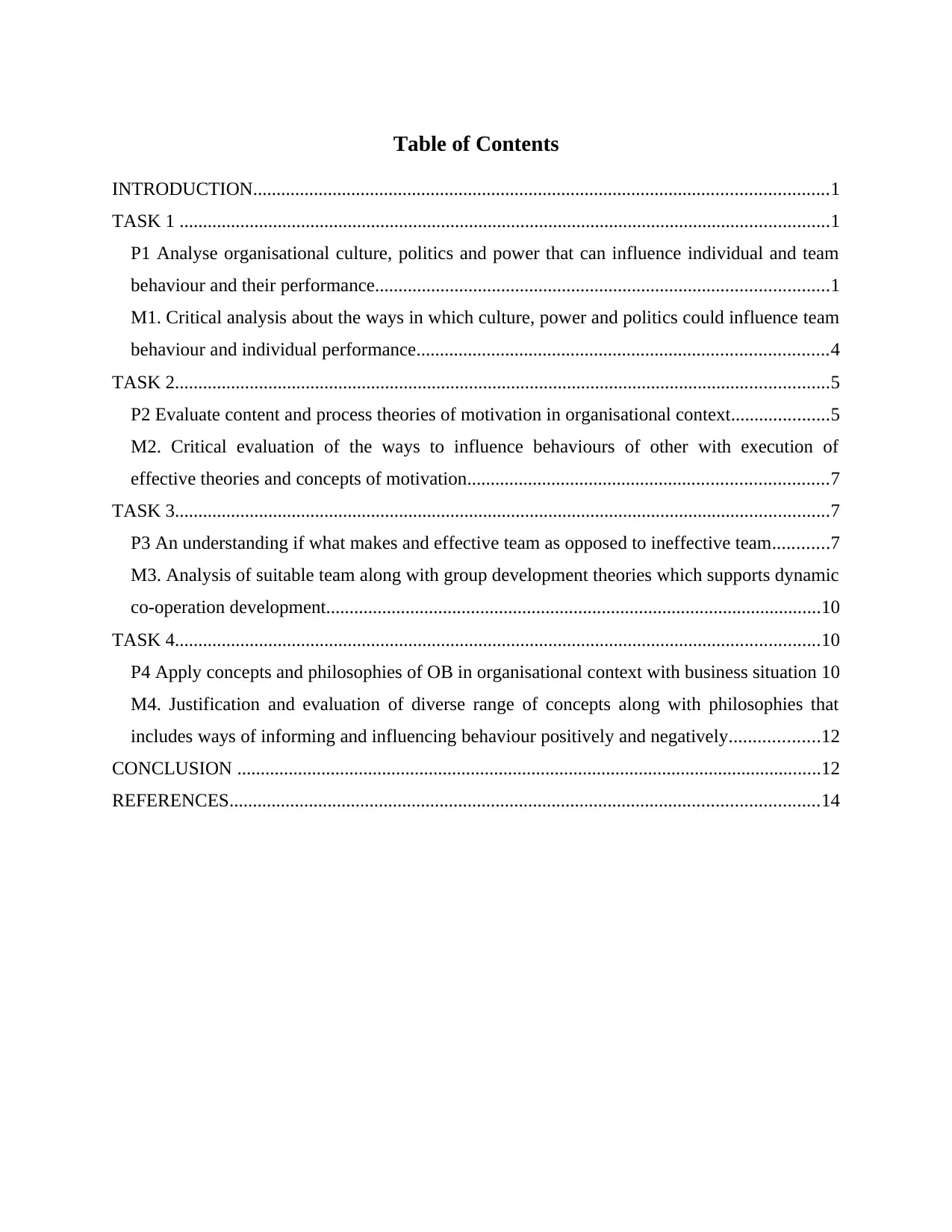
Table of Contents
INTRODUCTION...........................................................................................................................1
TASK 1 ...........................................................................................................................................1
P1 Analyse organisational culture, politics and power that can influence individual and team
behaviour and their performance.................................................................................................1
M1. Critical analysis about the ways in which culture, power and politics could influence team
behaviour and individual performance........................................................................................4
TASK 2............................................................................................................................................5
P2 Evaluate content and process theories of motivation in organisational context.....................5
M2. Critical evaluation of the ways to influence behaviours of other with execution of
effective theories and concepts of motivation.............................................................................7
TASK 3............................................................................................................................................7
P3 An understanding if what makes and effective team as opposed to ineffective team............7
M3. Analysis of suitable team along with group development theories which supports dynamic
co-operation development..........................................................................................................10
TASK 4..........................................................................................................................................10
P4 Apply concepts and philosophies of OB in organisational context with business situation 10
M4. Justification and evaluation of diverse range of concepts along with philosophies that
includes ways of informing and influencing behaviour positively and negatively...................12
CONCLUSION .............................................................................................................................12
REFERENCES..............................................................................................................................14
INTRODUCTION...........................................................................................................................1
TASK 1 ...........................................................................................................................................1
P1 Analyse organisational culture, politics and power that can influence individual and team
behaviour and their performance.................................................................................................1
M1. Critical analysis about the ways in which culture, power and politics could influence team
behaviour and individual performance........................................................................................4
TASK 2............................................................................................................................................5
P2 Evaluate content and process theories of motivation in organisational context.....................5
M2. Critical evaluation of the ways to influence behaviours of other with execution of
effective theories and concepts of motivation.............................................................................7
TASK 3............................................................................................................................................7
P3 An understanding if what makes and effective team as opposed to ineffective team............7
M3. Analysis of suitable team along with group development theories which supports dynamic
co-operation development..........................................................................................................10
TASK 4..........................................................................................................................................10
P4 Apply concepts and philosophies of OB in organisational context with business situation 10
M4. Justification and evaluation of diverse range of concepts along with philosophies that
includes ways of informing and influencing behaviour positively and negatively...................12
CONCLUSION .............................................................................................................................12
REFERENCES..............................................................................................................................14

⊘ This is a preview!⊘
Do you want full access?
Subscribe today to unlock all pages.

Trusted by 1+ million students worldwide
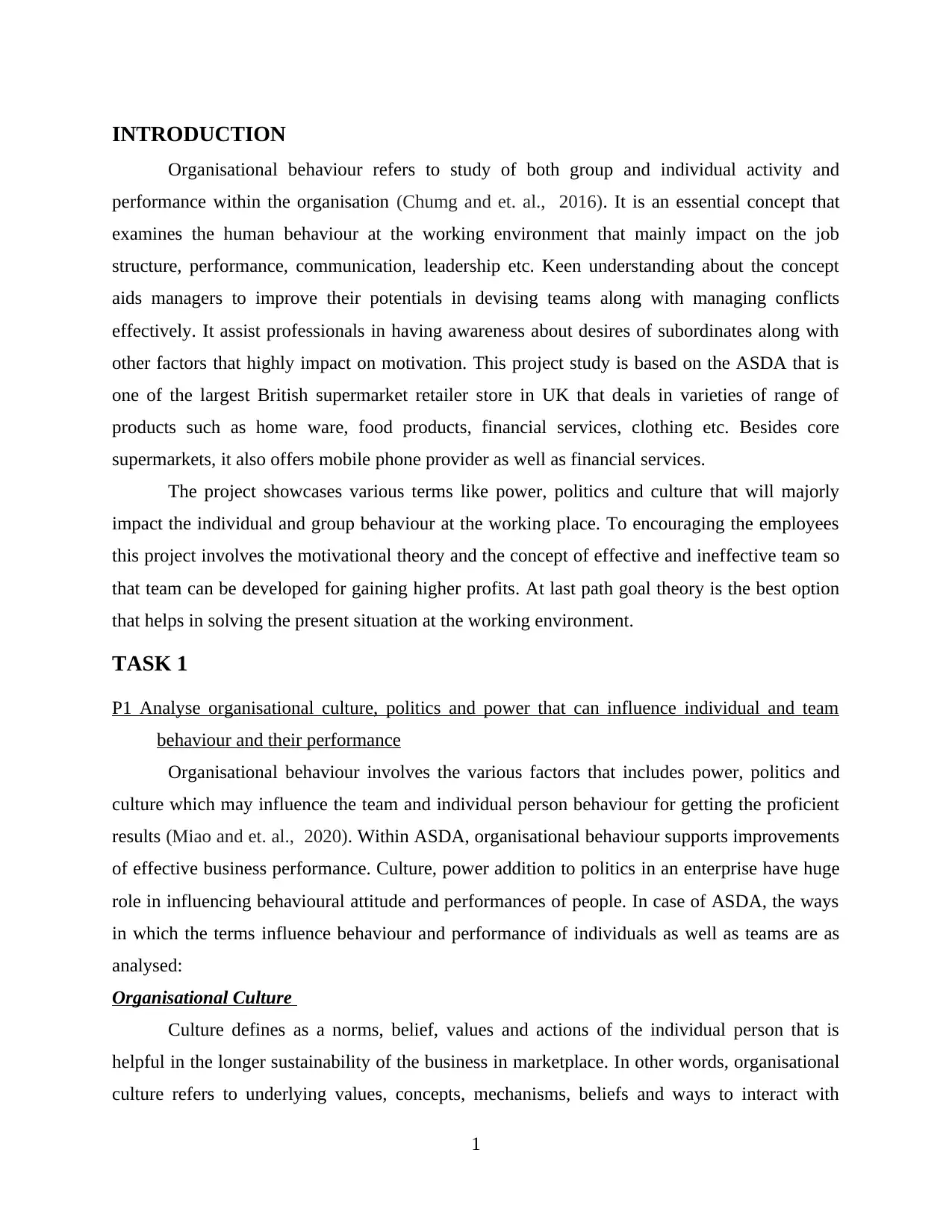
INTRODUCTION
Organisational behaviour refers to study of both group and individual activity and
performance within the organisation (Chumg and et. al., 2016). It is an essential concept that
examines the human behaviour at the working environment that mainly impact on the job
structure, performance, communication, leadership etc. Keen understanding about the concept
aids managers to improve their potentials in devising teams along with managing conflicts
effectively. It assist professionals in having awareness about desires of subordinates along with
other factors that highly impact on motivation. This project study is based on the ASDA that is
one of the largest British supermarket retailer store in UK that deals in varieties of range of
products such as home ware, food products, financial services, clothing etc. Besides core
supermarkets, it also offers mobile phone provider as well as financial services.
The project showcases various terms like power, politics and culture that will majorly
impact the individual and group behaviour at the working place. To encouraging the employees
this project involves the motivational theory and the concept of effective and ineffective team so
that team can be developed for gaining higher profits. At last path goal theory is the best option
that helps in solving the present situation at the working environment.
TASK 1
P1 Analyse organisational culture, politics and power that can influence individual and team
behaviour and their performance
Organisational behaviour involves the various factors that includes power, politics and
culture which may influence the team and individual person behaviour for getting the proficient
results (Miao and et. al., 2020). Within ASDA, organisational behaviour supports improvements
of effective business performance. Culture, power addition to politics in an enterprise have huge
role in influencing behavioural attitude and performances of people. In case of ASDA, the ways
in which the terms influence behaviour and performance of individuals as well as teams are as
analysed:
Organisational Culture
Culture defines as a norms, belief, values and actions of the individual person that is
helpful in the longer sustainability of the business in marketplace. In other words, organisational
culture refers to underlying values, concepts, mechanisms, beliefs and ways to interact with
1
Organisational behaviour refers to study of both group and individual activity and
performance within the organisation (Chumg and et. al., 2016). It is an essential concept that
examines the human behaviour at the working environment that mainly impact on the job
structure, performance, communication, leadership etc. Keen understanding about the concept
aids managers to improve their potentials in devising teams along with managing conflicts
effectively. It assist professionals in having awareness about desires of subordinates along with
other factors that highly impact on motivation. This project study is based on the ASDA that is
one of the largest British supermarket retailer store in UK that deals in varieties of range of
products such as home ware, food products, financial services, clothing etc. Besides core
supermarkets, it also offers mobile phone provider as well as financial services.
The project showcases various terms like power, politics and culture that will majorly
impact the individual and group behaviour at the working place. To encouraging the employees
this project involves the motivational theory and the concept of effective and ineffective team so
that team can be developed for gaining higher profits. At last path goal theory is the best option
that helps in solving the present situation at the working environment.
TASK 1
P1 Analyse organisational culture, politics and power that can influence individual and team
behaviour and their performance
Organisational behaviour involves the various factors that includes power, politics and
culture which may influence the team and individual person behaviour for getting the proficient
results (Miao and et. al., 2020). Within ASDA, organisational behaviour supports improvements
of effective business performance. Culture, power addition to politics in an enterprise have huge
role in influencing behavioural attitude and performances of people. In case of ASDA, the ways
in which the terms influence behaviour and performance of individuals as well as teams are as
analysed:
Organisational Culture
Culture defines as a norms, belief, values and actions of the individual person that is
helpful in the longer sustainability of the business in marketplace. In other words, organisational
culture refers to underlying values, concepts, mechanisms, beliefs and ways to interact with
1
Paraphrase This Document
Need a fresh take? Get an instant paraphrase of this document with our AI Paraphraser
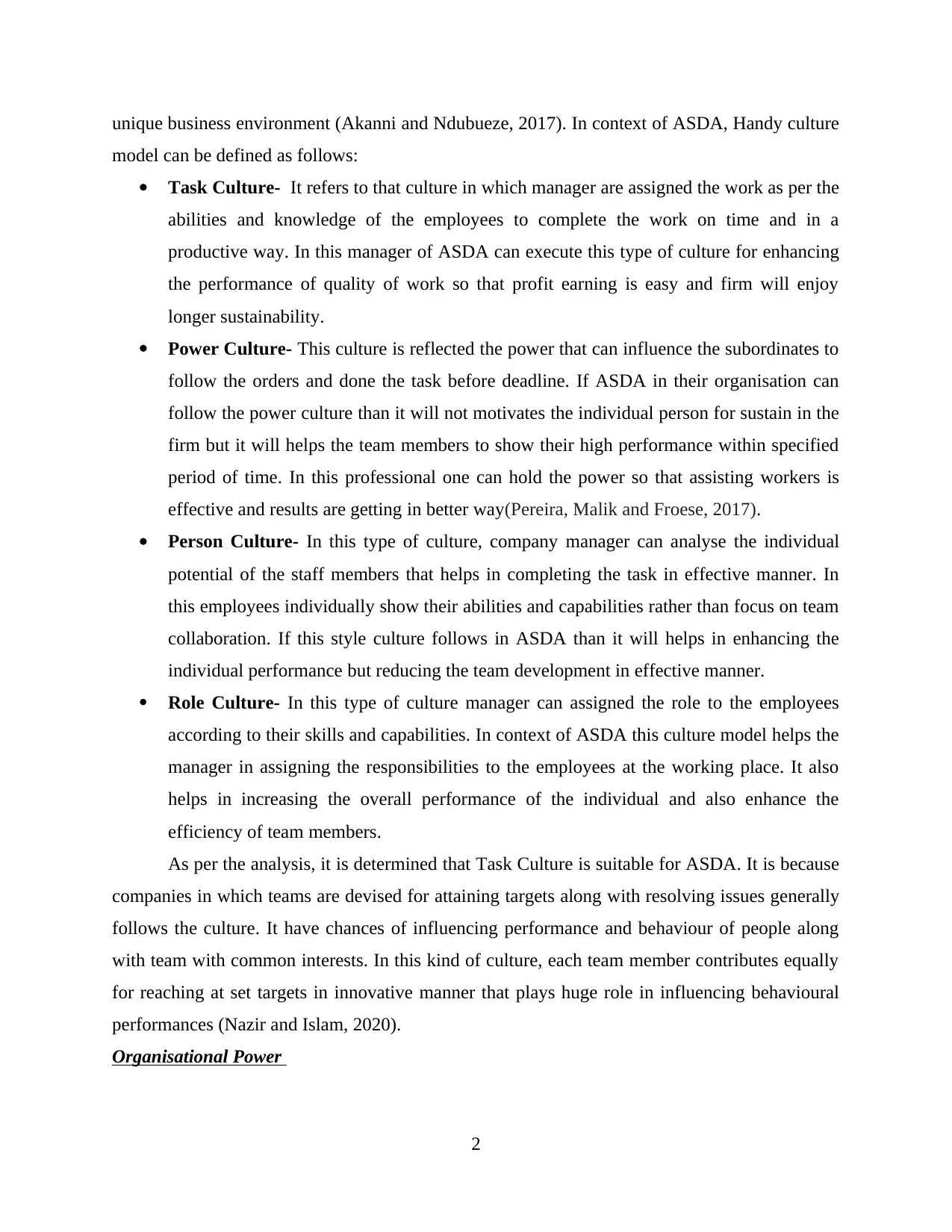
unique business environment (Akanni and Ndubueze, 2017). In context of ASDA, Handy culture
model can be defined as follows:
Task Culture- It refers to that culture in which manager are assigned the work as per the
abilities and knowledge of the employees to complete the work on time and in a
productive way. In this manager of ASDA can execute this type of culture for enhancing
the performance of quality of work so that profit earning is easy and firm will enjoy
longer sustainability.
Power Culture- This culture is reflected the power that can influence the subordinates to
follow the orders and done the task before deadline. If ASDA in their organisation can
follow the power culture than it will not motivates the individual person for sustain in the
firm but it will helps the team members to show their high performance within specified
period of time. In this professional one can hold the power so that assisting workers is
effective and results are getting in better way(Pereira, Malik and Froese, 2017).
Person Culture- In this type of culture, company manager can analyse the individual
potential of the staff members that helps in completing the task in effective manner. In
this employees individually show their abilities and capabilities rather than focus on team
collaboration. If this style culture follows in ASDA than it will helps in enhancing the
individual performance but reducing the team development in effective manner.
Role Culture- In this type of culture manager can assigned the role to the employees
according to their skills and capabilities. In context of ASDA this culture model helps the
manager in assigning the responsibilities to the employees at the working place. It also
helps in increasing the overall performance of the individual and also enhance the
efficiency of team members.
As per the analysis, it is determined that Task Culture is suitable for ASDA. It is because
companies in which teams are devised for attaining targets along with resolving issues generally
follows the culture. It have chances of influencing performance and behaviour of people along
with team with common interests. In this kind of culture, each team member contributes equally
for reaching at set targets in innovative manner that plays huge role in influencing behavioural
performances (Nazir and Islam, 2020).
Organisational Power
2
model can be defined as follows:
Task Culture- It refers to that culture in which manager are assigned the work as per the
abilities and knowledge of the employees to complete the work on time and in a
productive way. In this manager of ASDA can execute this type of culture for enhancing
the performance of quality of work so that profit earning is easy and firm will enjoy
longer sustainability.
Power Culture- This culture is reflected the power that can influence the subordinates to
follow the orders and done the task before deadline. If ASDA in their organisation can
follow the power culture than it will not motivates the individual person for sustain in the
firm but it will helps the team members to show their high performance within specified
period of time. In this professional one can hold the power so that assisting workers is
effective and results are getting in better way(Pereira, Malik and Froese, 2017).
Person Culture- In this type of culture, company manager can analyse the individual
potential of the staff members that helps in completing the task in effective manner. In
this employees individually show their abilities and capabilities rather than focus on team
collaboration. If this style culture follows in ASDA than it will helps in enhancing the
individual performance but reducing the team development in effective manner.
Role Culture- In this type of culture manager can assigned the role to the employees
according to their skills and capabilities. In context of ASDA this culture model helps the
manager in assigning the responsibilities to the employees at the working place. It also
helps in increasing the overall performance of the individual and also enhance the
efficiency of team members.
As per the analysis, it is determined that Task Culture is suitable for ASDA. It is because
companies in which teams are devised for attaining targets along with resolving issues generally
follows the culture. It have chances of influencing performance and behaviour of people along
with team with common interests. In this kind of culture, each team member contributes equally
for reaching at set targets in innovative manner that plays huge role in influencing behavioural
performances (Nazir and Islam, 2020).
Organisational Power
2
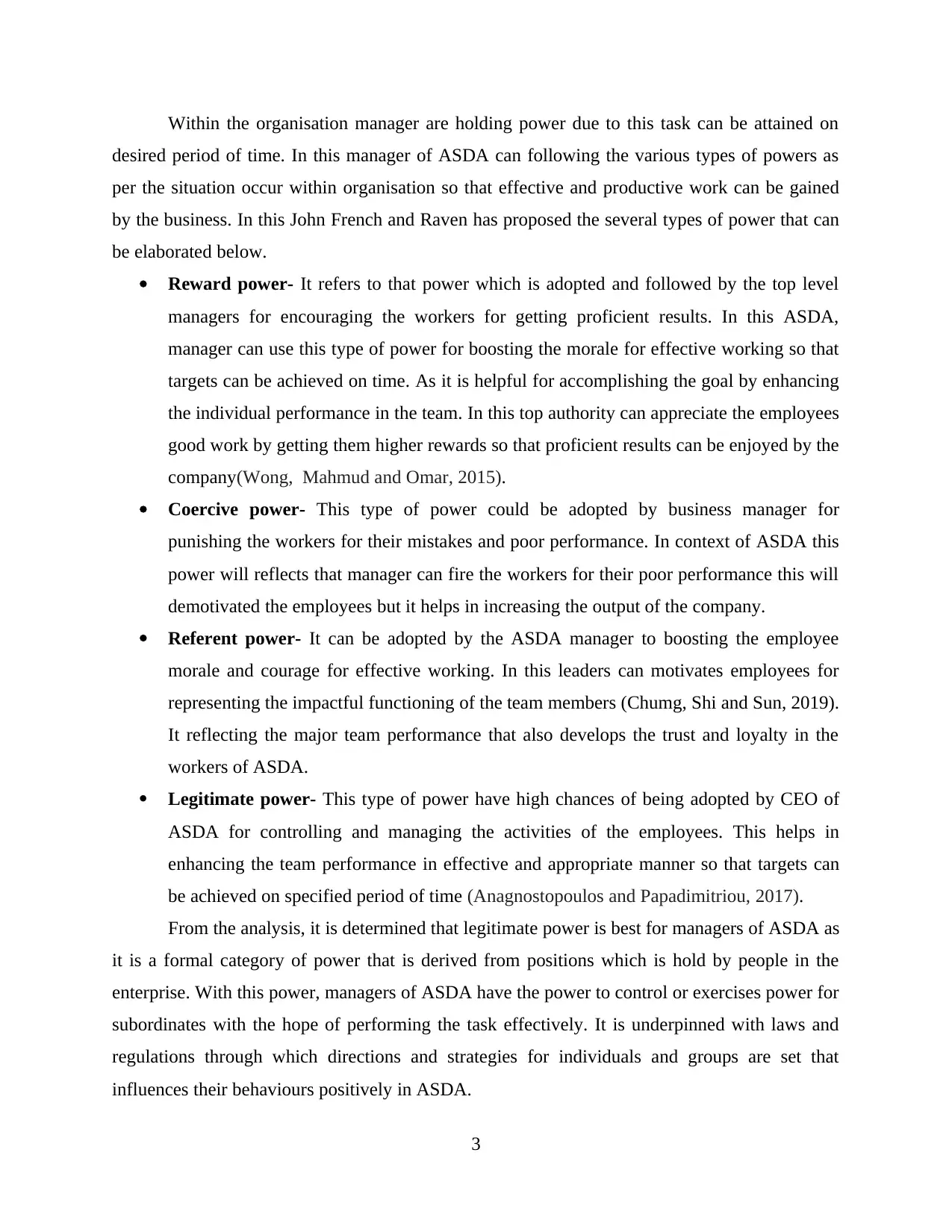
Within the organisation manager are holding power due to this task can be attained on
desired period of time. In this manager of ASDA can following the various types of powers as
per the situation occur within organisation so that effective and productive work can be gained
by the business. In this John French and Raven has proposed the several types of power that can
be elaborated below.
Reward power- It refers to that power which is adopted and followed by the top level
managers for encouraging the workers for getting proficient results. In this ASDA,
manager can use this type of power for boosting the morale for effective working so that
targets can be achieved on time. As it is helpful for accomplishing the goal by enhancing
the individual performance in the team. In this top authority can appreciate the employees
good work by getting them higher rewards so that proficient results can be enjoyed by the
company(Wong, Mahmud and Omar, 2015).
Coercive power- This type of power could be adopted by business manager for
punishing the workers for their mistakes and poor performance. In context of ASDA this
power will reflects that manager can fire the workers for their poor performance this will
demotivated the employees but it helps in increasing the output of the company.
Referent power- It can be adopted by the ASDA manager to boosting the employee
morale and courage for effective working. In this leaders can motivates employees for
representing the impactful functioning of the team members (Chumg, Shi and Sun, 2019).
It reflecting the major team performance that also develops the trust and loyalty in the
workers of ASDA.
Legitimate power- This type of power have high chances of being adopted by CEO of
ASDA for controlling and managing the activities of the employees. This helps in
enhancing the team performance in effective and appropriate manner so that targets can
be achieved on specified period of time (Anagnostopoulos and Papadimitriou, 2017).
From the analysis, it is determined that legitimate power is best for managers of ASDA as
it is a formal category of power that is derived from positions which is hold by people in the
enterprise. With this power, managers of ASDA have the power to control or exercises power for
subordinates with the hope of performing the task effectively. It is underpinned with laws and
regulations through which directions and strategies for individuals and groups are set that
influences their behaviours positively in ASDA.
3
desired period of time. In this manager of ASDA can following the various types of powers as
per the situation occur within organisation so that effective and productive work can be gained
by the business. In this John French and Raven has proposed the several types of power that can
be elaborated below.
Reward power- It refers to that power which is adopted and followed by the top level
managers for encouraging the workers for getting proficient results. In this ASDA,
manager can use this type of power for boosting the morale for effective working so that
targets can be achieved on time. As it is helpful for accomplishing the goal by enhancing
the individual performance in the team. In this top authority can appreciate the employees
good work by getting them higher rewards so that proficient results can be enjoyed by the
company(Wong, Mahmud and Omar, 2015).
Coercive power- This type of power could be adopted by business manager for
punishing the workers for their mistakes and poor performance. In context of ASDA this
power will reflects that manager can fire the workers for their poor performance this will
demotivated the employees but it helps in increasing the output of the company.
Referent power- It can be adopted by the ASDA manager to boosting the employee
morale and courage for effective working. In this leaders can motivates employees for
representing the impactful functioning of the team members (Chumg, Shi and Sun, 2019).
It reflecting the major team performance that also develops the trust and loyalty in the
workers of ASDA.
Legitimate power- This type of power have high chances of being adopted by CEO of
ASDA for controlling and managing the activities of the employees. This helps in
enhancing the team performance in effective and appropriate manner so that targets can
be achieved on specified period of time (Anagnostopoulos and Papadimitriou, 2017).
From the analysis, it is determined that legitimate power is best for managers of ASDA as
it is a formal category of power that is derived from positions which is hold by people in the
enterprise. With this power, managers of ASDA have the power to control or exercises power for
subordinates with the hope of performing the task effectively. It is underpinned with laws and
regulations through which directions and strategies for individuals and groups are set that
influences their behaviours positively in ASDA.
3
⊘ This is a preview!⊘
Do you want full access?
Subscribe today to unlock all pages.

Trusted by 1+ million students worldwide
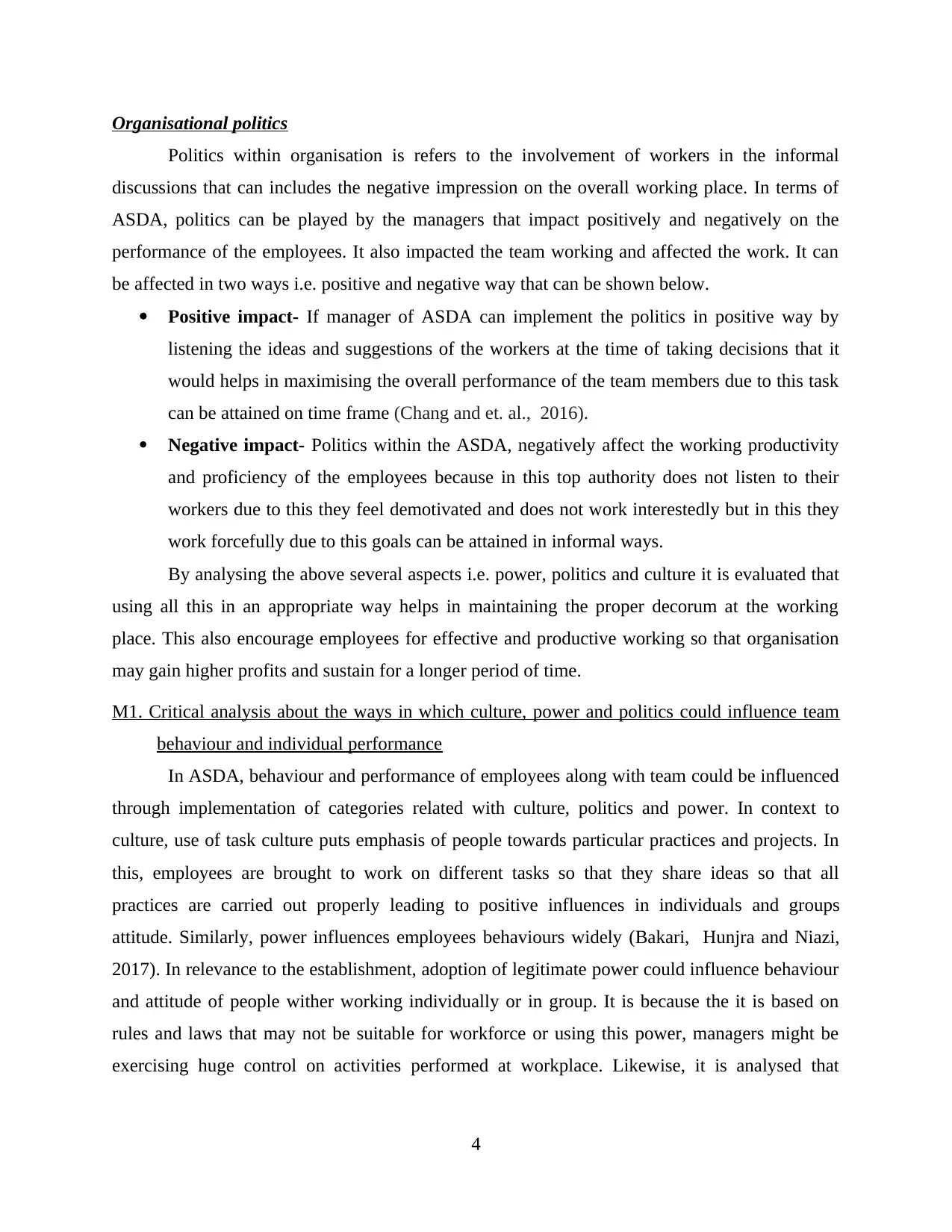
Organisational politics
Politics within organisation is refers to the involvement of workers in the informal
discussions that can includes the negative impression on the overall working place. In terms of
ASDA, politics can be played by the managers that impact positively and negatively on the
performance of the employees. It also impacted the team working and affected the work. It can
be affected in two ways i.e. positive and negative way that can be shown below.
Positive impact- If manager of ASDA can implement the politics in positive way by
listening the ideas and suggestions of the workers at the time of taking decisions that it
would helps in maximising the overall performance of the team members due to this task
can be attained on time frame (Chang and et. al., 2016).
Negative impact- Politics within the ASDA, negatively affect the working productivity
and proficiency of the employees because in this top authority does not listen to their
workers due to this they feel demotivated and does not work interestedly but in this they
work forcefully due to this goals can be attained in informal ways.
By analysing the above several aspects i.e. power, politics and culture it is evaluated that
using all this in an appropriate way helps in maintaining the proper decorum at the working
place. This also encourage employees for effective and productive working so that organisation
may gain higher profits and sustain for a longer period of time.
M1. Critical analysis about the ways in which culture, power and politics could influence team
behaviour and individual performance
In ASDA, behaviour and performance of employees along with team could be influenced
through implementation of categories related with culture, politics and power. In context to
culture, use of task culture puts emphasis of people towards particular practices and projects. In
this, employees are brought to work on different tasks so that they share ideas so that all
practices are carried out properly leading to positive influences in individuals and groups
attitude. Similarly, power influences employees behaviours widely (Bakari, Hunjra and Niazi,
2017). In relevance to the establishment, adoption of legitimate power could influence behaviour
and attitude of people wither working individually or in group. It is because the it is based on
rules and laws that may not be suitable for workforce or using this power, managers might be
exercising huge control on activities performed at workplace. Likewise, it is analysed that
4
Politics within organisation is refers to the involvement of workers in the informal
discussions that can includes the negative impression on the overall working place. In terms of
ASDA, politics can be played by the managers that impact positively and negatively on the
performance of the employees. It also impacted the team working and affected the work. It can
be affected in two ways i.e. positive and negative way that can be shown below.
Positive impact- If manager of ASDA can implement the politics in positive way by
listening the ideas and suggestions of the workers at the time of taking decisions that it
would helps in maximising the overall performance of the team members due to this task
can be attained on time frame (Chang and et. al., 2016).
Negative impact- Politics within the ASDA, negatively affect the working productivity
and proficiency of the employees because in this top authority does not listen to their
workers due to this they feel demotivated and does not work interestedly but in this they
work forcefully due to this goals can be attained in informal ways.
By analysing the above several aspects i.e. power, politics and culture it is evaluated that
using all this in an appropriate way helps in maintaining the proper decorum at the working
place. This also encourage employees for effective and productive working so that organisation
may gain higher profits and sustain for a longer period of time.
M1. Critical analysis about the ways in which culture, power and politics could influence team
behaviour and individual performance
In ASDA, behaviour and performance of employees along with team could be influenced
through implementation of categories related with culture, politics and power. In context to
culture, use of task culture puts emphasis of people towards particular practices and projects. In
this, employees are brought to work on different tasks so that they share ideas so that all
practices are carried out properly leading to positive influences in individuals and groups
attitude. Similarly, power influences employees behaviours widely (Bakari, Hunjra and Niazi,
2017). In relevance to the establishment, adoption of legitimate power could influence behaviour
and attitude of people wither working individually or in group. It is because the it is based on
rules and laws that may not be suitable for workforce or using this power, managers might be
exercising huge control on activities performed at workplace. Likewise, it is analysed that
4
Paraphrase This Document
Need a fresh take? Get an instant paraphrase of this document with our AI Paraphraser
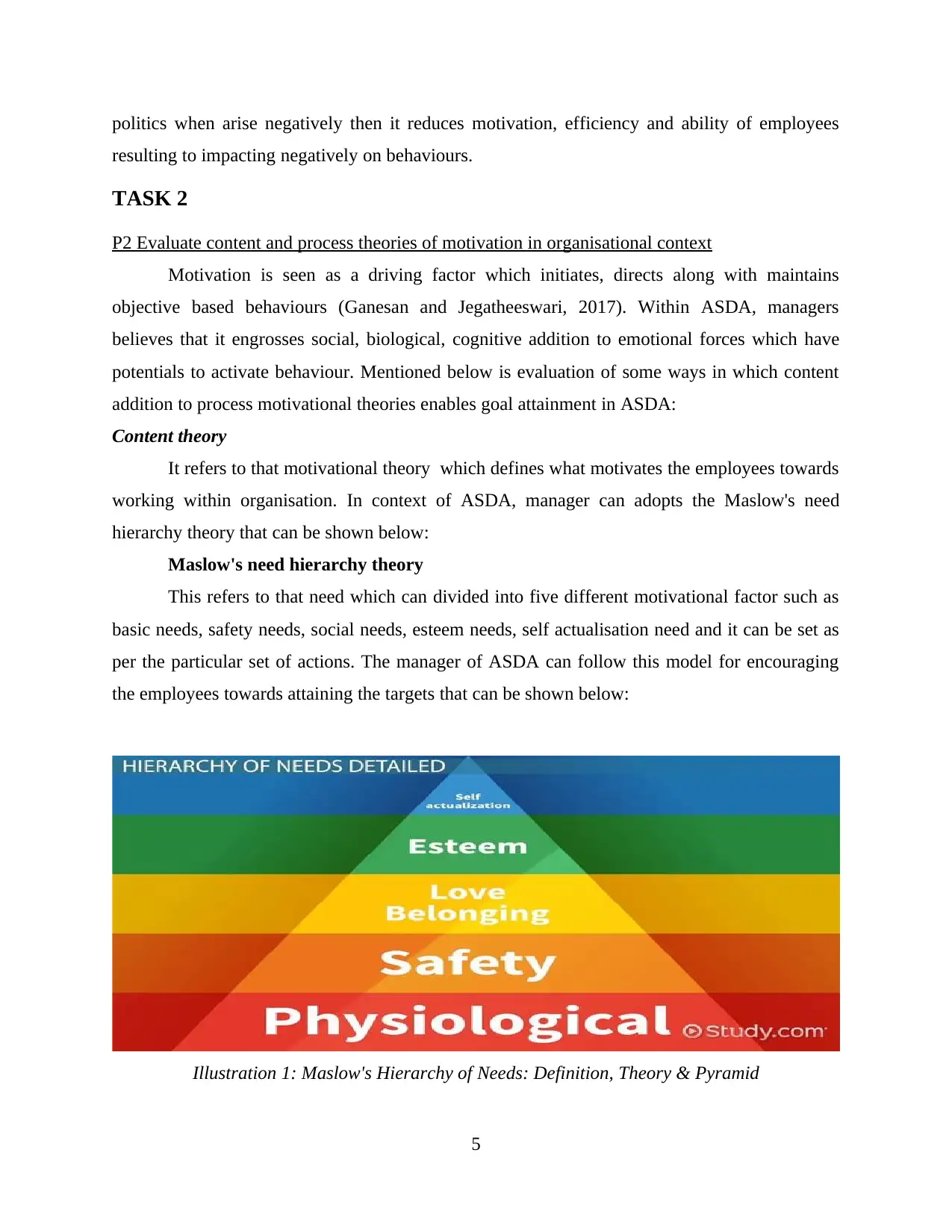
politics when arise negatively then it reduces motivation, efficiency and ability of employees
resulting to impacting negatively on behaviours.
TASK 2
P2 Evaluate content and process theories of motivation in organisational context
Motivation is seen as a driving factor which initiates, directs along with maintains
objective based behaviours (Ganesan and Jegatheeswari, 2017). Within ASDA, managers
believes that it engrosses social, biological, cognitive addition to emotional forces which have
potentials to activate behaviour. Mentioned below is evaluation of some ways in which content
addition to process motivational theories enables goal attainment in ASDA:
Content theory
It refers to that motivational theory which defines what motivates the employees towards
working within organisation. In context of ASDA, manager can adopts the Maslow's need
hierarchy theory that can be shown below:
Maslow's need hierarchy theory
This refers to that need which can divided into five different motivational factor such as
basic needs, safety needs, social needs, esteem needs, self actualisation need and it can be set as
per the particular set of actions. The manager of ASDA can follow this model for encouraging
the employees towards attaining the targets that can be shown below:
Illustration 1: Maslow's Hierarchy of Needs: Definition, Theory & Pyramid
5
resulting to impacting negatively on behaviours.
TASK 2
P2 Evaluate content and process theories of motivation in organisational context
Motivation is seen as a driving factor which initiates, directs along with maintains
objective based behaviours (Ganesan and Jegatheeswari, 2017). Within ASDA, managers
believes that it engrosses social, biological, cognitive addition to emotional forces which have
potentials to activate behaviour. Mentioned below is evaluation of some ways in which content
addition to process motivational theories enables goal attainment in ASDA:
Content theory
It refers to that motivational theory which defines what motivates the employees towards
working within organisation. In context of ASDA, manager can adopts the Maslow's need
hierarchy theory that can be shown below:
Maslow's need hierarchy theory
This refers to that need which can divided into five different motivational factor such as
basic needs, safety needs, social needs, esteem needs, self actualisation need and it can be set as
per the particular set of actions. The manager of ASDA can follow this model for encouraging
the employees towards attaining the targets that can be shown below:
Illustration 1: Maslow's Hierarchy of Needs: Definition, Theory & Pyramid
5
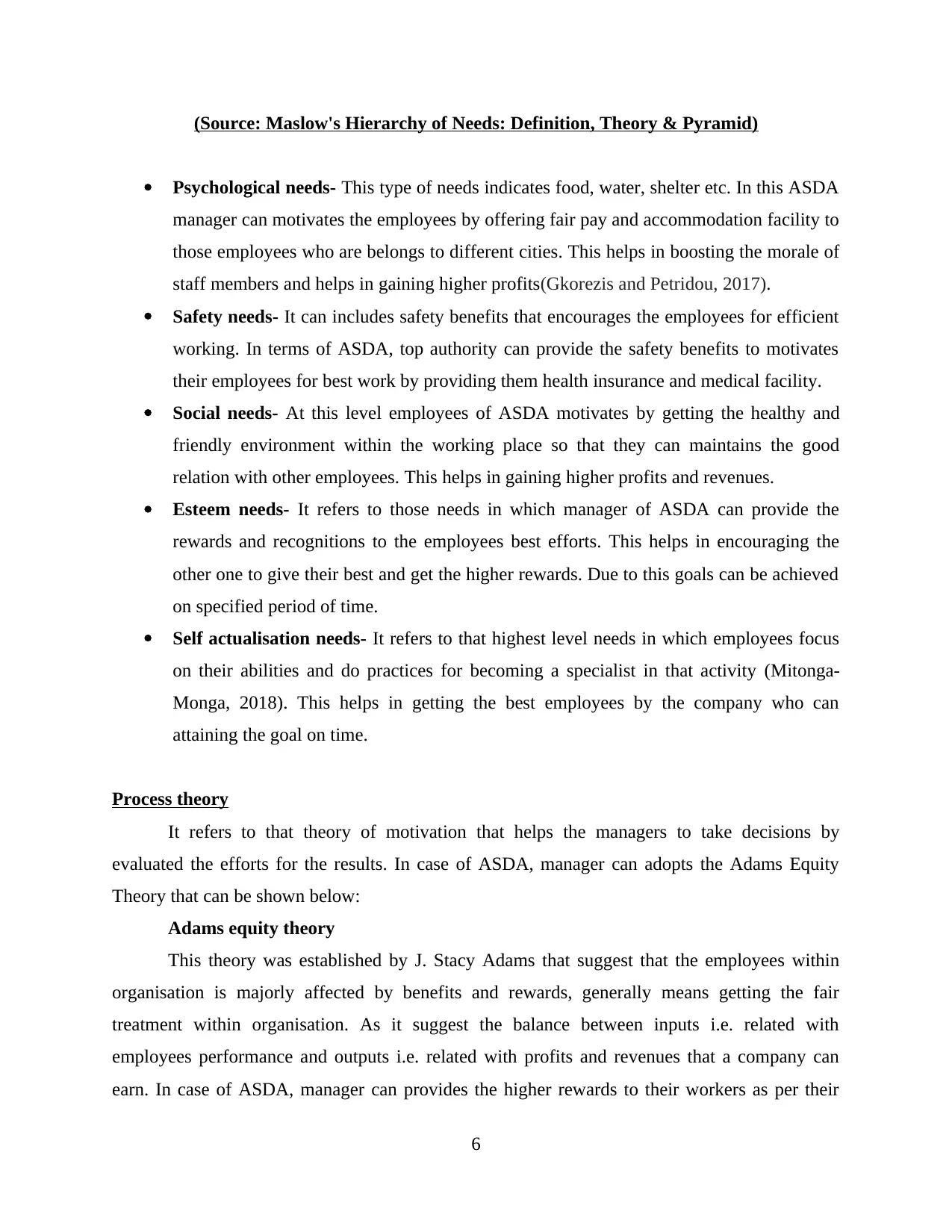
(Source: Maslow's Hierarchy of Needs: Definition, Theory & Pyramid)
Psychological needs- This type of needs indicates food, water, shelter etc. In this ASDA
manager can motivates the employees by offering fair pay and accommodation facility to
those employees who are belongs to different cities. This helps in boosting the morale of
staff members and helps in gaining higher profits(Gkorezis and Petridou, 2017).
Safety needs- It can includes safety benefits that encourages the employees for efficient
working. In terms of ASDA, top authority can provide the safety benefits to motivates
their employees for best work by providing them health insurance and medical facility.
Social needs- At this level employees of ASDA motivates by getting the healthy and
friendly environment within the working place so that they can maintains the good
relation with other employees. This helps in gaining higher profits and revenues.
Esteem needs- It refers to those needs in which manager of ASDA can provide the
rewards and recognitions to the employees best efforts. This helps in encouraging the
other one to give their best and get the higher rewards. Due to this goals can be achieved
on specified period of time.
Self actualisation needs- It refers to that highest level needs in which employees focus
on their abilities and do practices for becoming a specialist in that activity (Mitonga-
Monga, 2018). This helps in getting the best employees by the company who can
attaining the goal on time.
Process theory
It refers to that theory of motivation that helps the managers to take decisions by
evaluated the efforts for the results. In case of ASDA, manager can adopts the Adams Equity
Theory that can be shown below:
Adams equity theory
This theory was established by J. Stacy Adams that suggest that the employees within
organisation is majorly affected by benefits and rewards, generally means getting the fair
treatment within organisation. As it suggest the balance between inputs i.e. related with
employees performance and outputs i.e. related with profits and revenues that a company can
earn. In case of ASDA, manager can provides the higher rewards to their workers as per their
6
Psychological needs- This type of needs indicates food, water, shelter etc. In this ASDA
manager can motivates the employees by offering fair pay and accommodation facility to
those employees who are belongs to different cities. This helps in boosting the morale of
staff members and helps in gaining higher profits(Gkorezis and Petridou, 2017).
Safety needs- It can includes safety benefits that encourages the employees for efficient
working. In terms of ASDA, top authority can provide the safety benefits to motivates
their employees for best work by providing them health insurance and medical facility.
Social needs- At this level employees of ASDA motivates by getting the healthy and
friendly environment within the working place so that they can maintains the good
relation with other employees. This helps in gaining higher profits and revenues.
Esteem needs- It refers to those needs in which manager of ASDA can provide the
rewards and recognitions to the employees best efforts. This helps in encouraging the
other one to give their best and get the higher rewards. Due to this goals can be achieved
on specified period of time.
Self actualisation needs- It refers to that highest level needs in which employees focus
on their abilities and do practices for becoming a specialist in that activity (Mitonga-
Monga, 2018). This helps in getting the best employees by the company who can
attaining the goal on time.
Process theory
It refers to that theory of motivation that helps the managers to take decisions by
evaluated the efforts for the results. In case of ASDA, manager can adopts the Adams Equity
Theory that can be shown below:
Adams equity theory
This theory was established by J. Stacy Adams that suggest that the employees within
organisation is majorly affected by benefits and rewards, generally means getting the fair
treatment within organisation. As it suggest the balance between inputs i.e. related with
employees performance and outputs i.e. related with profits and revenues that a company can
earn. In case of ASDA, manager can provides the higher rewards to their workers as per their
6
⊘ This is a preview!⊘
Do you want full access?
Subscribe today to unlock all pages.

Trusted by 1+ million students worldwide
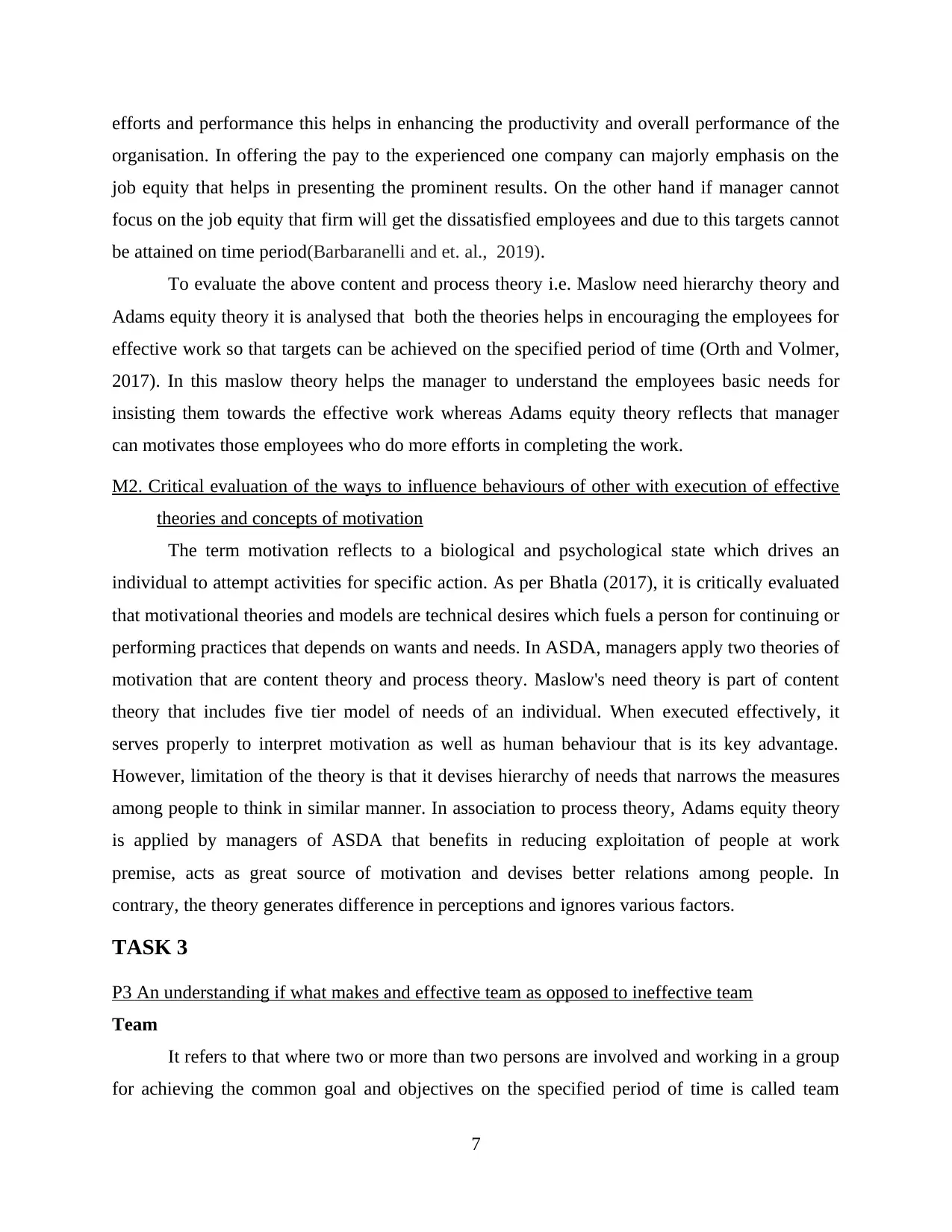
efforts and performance this helps in enhancing the productivity and overall performance of the
organisation. In offering the pay to the experienced one company can majorly emphasis on the
job equity that helps in presenting the prominent results. On the other hand if manager cannot
focus on the job equity that firm will get the dissatisfied employees and due to this targets cannot
be attained on time period(Barbaranelli and et. al., 2019).
To evaluate the above content and process theory i.e. Maslow need hierarchy theory and
Adams equity theory it is analysed that both the theories helps in encouraging the employees for
effective work so that targets can be achieved on the specified period of time (Orth and Volmer,
2017). In this maslow theory helps the manager to understand the employees basic needs for
insisting them towards the effective work whereas Adams equity theory reflects that manager
can motivates those employees who do more efforts in completing the work.
M2. Critical evaluation of the ways to influence behaviours of other with execution of effective
theories and concepts of motivation
The term motivation reflects to a biological and psychological state which drives an
individual to attempt activities for specific action. As per Bhatla (2017), it is critically evaluated
that motivational theories and models are technical desires which fuels a person for continuing or
performing practices that depends on wants and needs. In ASDA, managers apply two theories of
motivation that are content theory and process theory. Maslow's need theory is part of content
theory that includes five tier model of needs of an individual. When executed effectively, it
serves properly to interpret motivation as well as human behaviour that is its key advantage.
However, limitation of the theory is that it devises hierarchy of needs that narrows the measures
among people to think in similar manner. In association to process theory, Adams equity theory
is applied by managers of ASDA that benefits in reducing exploitation of people at work
premise, acts as great source of motivation and devises better relations among people. In
contrary, the theory generates difference in perceptions and ignores various factors.
TASK 3
P3 An understanding if what makes and effective team as opposed to ineffective team
Team
It refers to that where two or more than two persons are involved and working in a group
for achieving the common goal and objectives on the specified period of time is called team
7
organisation. In offering the pay to the experienced one company can majorly emphasis on the
job equity that helps in presenting the prominent results. On the other hand if manager cannot
focus on the job equity that firm will get the dissatisfied employees and due to this targets cannot
be attained on time period(Barbaranelli and et. al., 2019).
To evaluate the above content and process theory i.e. Maslow need hierarchy theory and
Adams equity theory it is analysed that both the theories helps in encouraging the employees for
effective work so that targets can be achieved on the specified period of time (Orth and Volmer,
2017). In this maslow theory helps the manager to understand the employees basic needs for
insisting them towards the effective work whereas Adams equity theory reflects that manager
can motivates those employees who do more efforts in completing the work.
M2. Critical evaluation of the ways to influence behaviours of other with execution of effective
theories and concepts of motivation
The term motivation reflects to a biological and psychological state which drives an
individual to attempt activities for specific action. As per Bhatla (2017), it is critically evaluated
that motivational theories and models are technical desires which fuels a person for continuing or
performing practices that depends on wants and needs. In ASDA, managers apply two theories of
motivation that are content theory and process theory. Maslow's need theory is part of content
theory that includes five tier model of needs of an individual. When executed effectively, it
serves properly to interpret motivation as well as human behaviour that is its key advantage.
However, limitation of the theory is that it devises hierarchy of needs that narrows the measures
among people to think in similar manner. In association to process theory, Adams equity theory
is applied by managers of ASDA that benefits in reducing exploitation of people at work
premise, acts as great source of motivation and devises better relations among people. In
contrary, the theory generates difference in perceptions and ignores various factors.
TASK 3
P3 An understanding if what makes and effective team as opposed to ineffective team
Team
It refers to that where two or more than two persons are involved and working in a group
for achieving the common goal and objectives on the specified period of time is called team
7
Paraphrase This Document
Need a fresh take? Get an instant paraphrase of this document with our AI Paraphraser
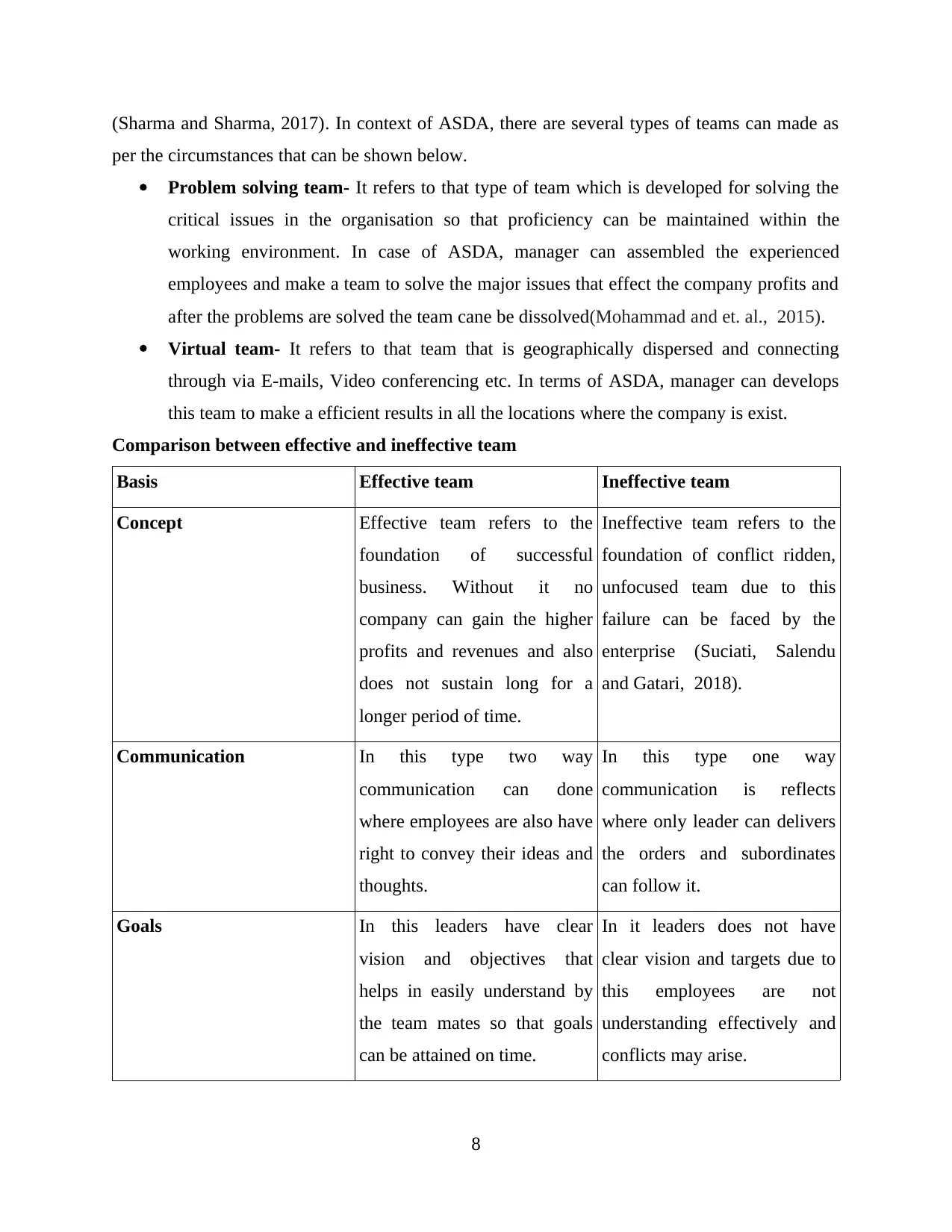
(Sharma and Sharma, 2017). In context of ASDA, there are several types of teams can made as
per the circumstances that can be shown below.
Problem solving team- It refers to that type of team which is developed for solving the
critical issues in the organisation so that proficiency can be maintained within the
working environment. In case of ASDA, manager can assembled the experienced
employees and make a team to solve the major issues that effect the company profits and
after the problems are solved the team cane be dissolved(Mohammad and et. al., 2015).
Virtual team- It refers to that team that is geographically dispersed and connecting
through via E-mails, Video conferencing etc. In terms of ASDA, manager can develops
this team to make a efficient results in all the locations where the company is exist.
Comparison between effective and ineffective team
Basis Effective team Ineffective team
Concept Effective team refers to the
foundation of successful
business. Without it no
company can gain the higher
profits and revenues and also
does not sustain long for a
longer period of time.
Ineffective team refers to the
foundation of conflict ridden,
unfocused team due to this
failure can be faced by the
enterprise (Suciati, Salendu
and Gatari, 2018).
Communication In this type two way
communication can done
where employees are also have
right to convey their ideas and
thoughts.
In this type one way
communication is reflects
where only leader can delivers
the orders and subordinates
can follow it.
Goals In this leaders have clear
vision and objectives that
helps in easily understand by
the team mates so that goals
can be attained on time.
In it leaders does not have
clear vision and targets due to
this employees are not
understanding effectively and
conflicts may arise.
8
per the circumstances that can be shown below.
Problem solving team- It refers to that type of team which is developed for solving the
critical issues in the organisation so that proficiency can be maintained within the
working environment. In case of ASDA, manager can assembled the experienced
employees and make a team to solve the major issues that effect the company profits and
after the problems are solved the team cane be dissolved(Mohammad and et. al., 2015).
Virtual team- It refers to that team that is geographically dispersed and connecting
through via E-mails, Video conferencing etc. In terms of ASDA, manager can develops
this team to make a efficient results in all the locations where the company is exist.
Comparison between effective and ineffective team
Basis Effective team Ineffective team
Concept Effective team refers to the
foundation of successful
business. Without it no
company can gain the higher
profits and revenues and also
does not sustain long for a
longer period of time.
Ineffective team refers to the
foundation of conflict ridden,
unfocused team due to this
failure can be faced by the
enterprise (Suciati, Salendu
and Gatari, 2018).
Communication In this type two way
communication can done
where employees are also have
right to convey their ideas and
thoughts.
In this type one way
communication is reflects
where only leader can delivers
the orders and subordinates
can follow it.
Goals In this leaders have clear
vision and objectives that
helps in easily understand by
the team mates so that goals
can be attained on time.
In it leaders does not have
clear vision and targets due to
this employees are not
understanding effectively and
conflicts may arise.
8
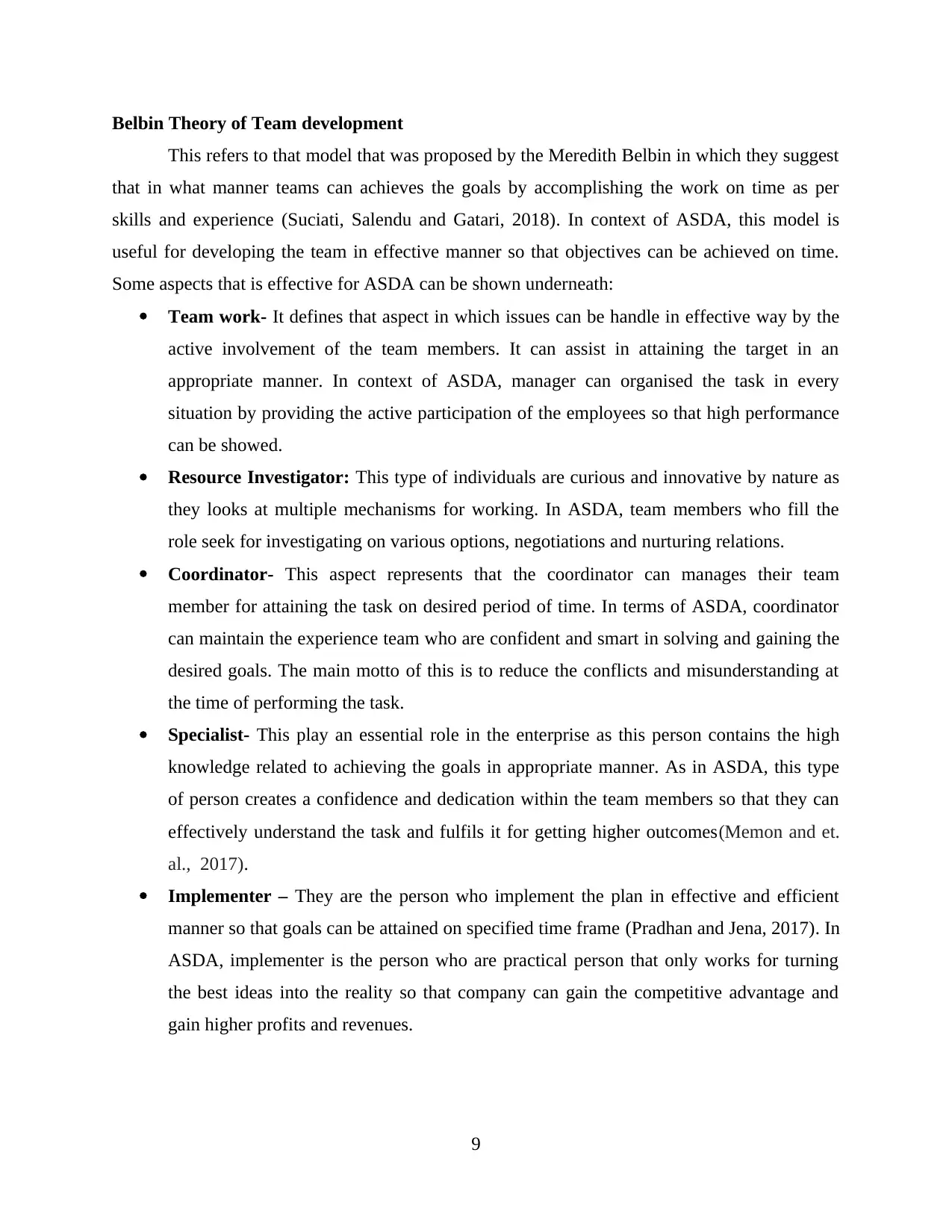
Belbin Theory of Team development
This refers to that model that was proposed by the Meredith Belbin in which they suggest
that in what manner teams can achieves the goals by accomplishing the work on time as per
skills and experience (Suciati, Salendu and Gatari, 2018). In context of ASDA, this model is
useful for developing the team in effective manner so that objectives can be achieved on time.
Some aspects that is effective for ASDA can be shown underneath:
Team work- It defines that aspect in which issues can be handle in effective way by the
active involvement of the team members. It can assist in attaining the target in an
appropriate manner. In context of ASDA, manager can organised the task in every
situation by providing the active participation of the employees so that high performance
can be showed.
Resource Investigator: This type of individuals are curious and innovative by nature as
they looks at multiple mechanisms for working. In ASDA, team members who fill the
role seek for investigating on various options, negotiations and nurturing relations.
Coordinator- This aspect represents that the coordinator can manages their team
member for attaining the task on desired period of time. In terms of ASDA, coordinator
can maintain the experience team who are confident and smart in solving and gaining the
desired goals. The main motto of this is to reduce the conflicts and misunderstanding at
the time of performing the task.
Specialist- This play an essential role in the enterprise as this person contains the high
knowledge related to achieving the goals in appropriate manner. As in ASDA, this type
of person creates a confidence and dedication within the team members so that they can
effectively understand the task and fulfils it for getting higher outcomes(Memon and et.
al., 2017).
Implementer – They are the person who implement the plan in effective and efficient
manner so that goals can be attained on specified time frame (Pradhan and Jena, 2017). In
ASDA, implementer is the person who are practical person that only works for turning
the best ideas into the reality so that company can gain the competitive advantage and
gain higher profits and revenues.
9
This refers to that model that was proposed by the Meredith Belbin in which they suggest
that in what manner teams can achieves the goals by accomplishing the work on time as per
skills and experience (Suciati, Salendu and Gatari, 2018). In context of ASDA, this model is
useful for developing the team in effective manner so that objectives can be achieved on time.
Some aspects that is effective for ASDA can be shown underneath:
Team work- It defines that aspect in which issues can be handle in effective way by the
active involvement of the team members. It can assist in attaining the target in an
appropriate manner. In context of ASDA, manager can organised the task in every
situation by providing the active participation of the employees so that high performance
can be showed.
Resource Investigator: This type of individuals are curious and innovative by nature as
they looks at multiple mechanisms for working. In ASDA, team members who fill the
role seek for investigating on various options, negotiations and nurturing relations.
Coordinator- This aspect represents that the coordinator can manages their team
member for attaining the task on desired period of time. In terms of ASDA, coordinator
can maintain the experience team who are confident and smart in solving and gaining the
desired goals. The main motto of this is to reduce the conflicts and misunderstanding at
the time of performing the task.
Specialist- This play an essential role in the enterprise as this person contains the high
knowledge related to achieving the goals in appropriate manner. As in ASDA, this type
of person creates a confidence and dedication within the team members so that they can
effectively understand the task and fulfils it for getting higher outcomes(Memon and et.
al., 2017).
Implementer – They are the person who implement the plan in effective and efficient
manner so that goals can be attained on specified time frame (Pradhan and Jena, 2017). In
ASDA, implementer is the person who are practical person that only works for turning
the best ideas into the reality so that company can gain the competitive advantage and
gain higher profits and revenues.
9
⊘ This is a preview!⊘
Do you want full access?
Subscribe today to unlock all pages.

Trusted by 1+ million students worldwide
1 out of 18
Related Documents
Your All-in-One AI-Powered Toolkit for Academic Success.
+13062052269
info@desklib.com
Available 24*7 on WhatsApp / Email
![[object Object]](/_next/static/media/star-bottom.7253800d.svg)
Unlock your academic potential
Copyright © 2020–2025 A2Z Services. All Rights Reserved. Developed and managed by ZUCOL.




